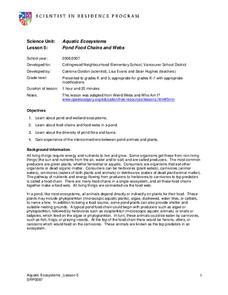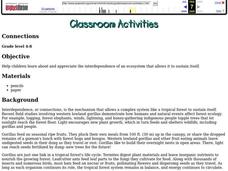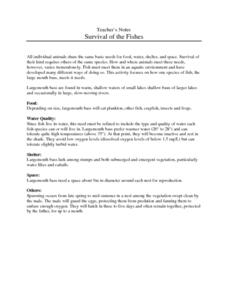Baylor College
A Place to Be
Home sweet home. Humans, birds, beavers, ants, we all need a place place to rest and keep us safe. In the ninth lesson plan of this series, the importance of shelter is discussed as the teacher reads aloud the book Tillena Lou's Day in...
Curated OER
Animal Signs
Students discuss the many different types of animal signs that can be used to identify and track animals. They participate in an hands-on activity in which they examine tracks, trails, homes, territory markings, and even "scat" left by...
National Wildlife Federation
Massive Migrations
Turn your students into flocks of migratory birds for this fun lesson on animal migration. Prior to the activity, the teacher creates four different migration routes in the classroom or any available open space, labeling nesting...
Curated OER
Animal Adaptations
Students expand their knowledge of animal features and behaviors that can help or hinder their survival in a particular habitat. They participate in classroom discussions and visit a website to research animals
Curated OER
Creating a Shelter
First graders create a small usable shelter for a small animal or an insect. In this shelter lesson plan, 1st graders use popsicle sticks, tree twigs, bottles, and more to build a shelter in groups.
Curated OER
Animal Adaptations
Young scholars will participate in classroom discussions and visit a website to learn more about animals and how well (or poorly) they've adapted to satisfying their needs in their natural habitats. This will help move them toward the...
Curated OER
Shelter/Refuge
Students research shelters and places of refuge for animals and humans. In this shelters activity, students read paragraphs about animal and human shelters. Students complete an activity about beavers and shelters. Students then complete...
National Gardening Association
Migration Mishaps
Elementary ecologists pretend to be migratory hummingbirds. They fly between wintering and nesting grounds, trying to reach a habitat haven. In a musical-chair fashion, some birds will miss out, and are removed from the game. To further...
National Wildlife Federation
What's Your Habitat?
How are third graders like rabbits? They both live in habitats and require food, water, and shelter to survive! An educational science instructional activity encourages your learners to think about their own habitats and survival needs,...
Curated OER
Shelter
Fourth graders listen as the teacher reads out loud "A House Is A House for Me". Each day for five days the students choose one activity out of two or three to complete. Conclusion arrives when all the students describe and write about...
Curated OER
Animal Habitats
Students study the word habitat and its meaning. They also identify that in order for something to be classified as a habitat there needs to be the proper shelter, food, water, and space.
Curated OER
Functional Homes
Students observe and reflect on habitats built and used by various life forms. They discover the benefits of the "homes" to the creature and its life and apply the natural designs to human uses.
Curated OER
Plants and Animals
Students find common needs between plants and animals. In this plants and animals instructional activity students compare that both plants and animals need food and water. They also find the differences between plant and animal needs.
Outdoor Learning Center
Outdoor Survival
Which of the following can you survive without for the longest time: water, food, or a positive mental attitude? The answer may surprise you. Guide learners of all ages through games, activities, and discussions about surviving in the...
Curated OER
Aquatic Ecosystems
Students study ponds and wetland ecosystems and examine the food chains and webs in them. For this aquatic ecosystems lesson students answer questions about the diversity of the flora and fauna in a pond.
Curated OER
CONNECTIONS
Young scholars study the interdependence of an ecosystem that allows it to sustain itself. They examine the Western lowland gorillas for an example.
Desert Discoveries
What's In A Habitat?
The concept of a habitat being a home for animals is the main thrust of this life sciences resource. Learners complete a cut-and-paste activity using a fine worksheet that's embedded in the plan. They must place four very different...
Curated OER
Pollination of Flowers by Moths
Turn your classroom into a pollination station as your kids transform into moths or predators trying to survive and aiding in plant reproduction along the way. Using silent party blowers as proboscises, the moths will have two minutes to...
Curated OER
Explore Your Natural Habitat
Students identify habitats and understand why they are important to our environment. For this environmental lesson students design their own habitat, observe and record data on the impact their habitat has on the environment.
Curated OER
Outdoor Survival
Learners are introduced to basic outdoor survival concepts. They identify the seven basic needs for survival. Students describe the symptoms and treatment for frostbite and hypothermia. They compare and contrast the value of different...
Curated OER
Habitat for Sale
Students are able to define habitat, and identify the four things that living things need to survive. They are able to describe how living things are adapted to their habitats.
Curated OER
A Natural Habitat: What, How and Why
Students understand what a habitat is. They determine why a habitat is important to our environment no matter where it is located. Students observe and recognize natural habitats in their surroundings.
Curated OER
Survival of the Fishes
Students study the aquatic environment in which largemouth bass are able to survive. They participate in a mystery animal activity based on their own basic needs to determine the identity of the largemouth bass.
Curated OER
Wildlife Habitat
High schoolers explain what a habitat is and describe its four elements. They see how an area's habitat suitability varies with different species of wildlife. They name factors that affect habitat suitability.

























